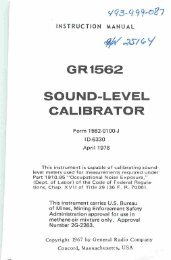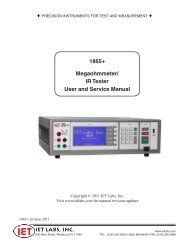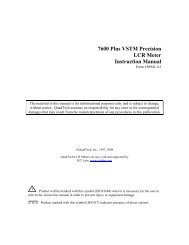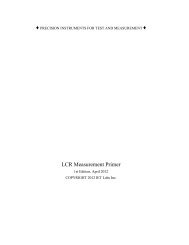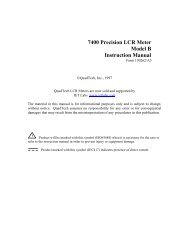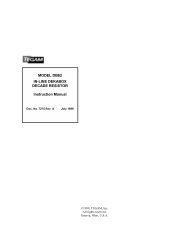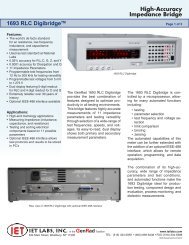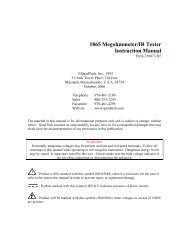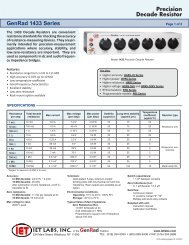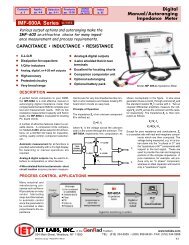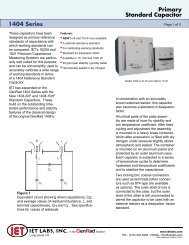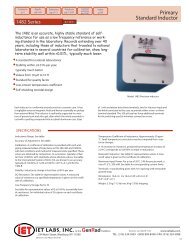Handbook of High Speed Photography - IET Labs, Inc.
Handbook of High Speed Photography - IET Labs, Inc.
Handbook of High Speed Photography - IET Labs, Inc.
Create successful ePaper yourself
Turn your PDF publications into a flip-book with our unique Google optimized e-Paper software.
Figure 1-2. A .22-calibre rifle bullet<br />
photographed in flight. The faint gray<br />
streak extending in front <strong>of</strong> the<br />
bullet along its path is exposure<br />
resulting from flash-larnp afterglow.<br />
A single, high-intensity flash <strong>of</strong> the<br />
Strobotac was triggered with a micro<br />
phone to stop the projectile's 1100-<br />
feet-per-second velocity. (Polaroid<br />
Type 47 film, ASA 3000, 3-microsecond<br />
exposure at f/22. The reflector<br />
was removed from the lamp.)<br />
Suppose, for example, a photograph is required <strong>of</strong> a .22-calibre<br />
rifle bullet in flight. The bullet travels about 1100 feet per second.<br />
During the 1-millisecond exposure produced by a mechanical shutter<br />
the bullet travels about 13 inches. During the 80-microsecond exposure<br />
<strong>of</strong> a high-speed movie camera, it moves about one inch, still too far<br />
for good photographic resolution. Needed for this and similar applica<br />
tions is an exposure time <strong>of</strong> a few microseconds. In 3.0 microseconds,<br />
for instance, the bullet travels only 0.04 inch (see Figure 1-2). An ex<br />
cellent example <strong>of</strong> what is possible using a single-flash <strong>of</strong> a few micro<br />
seconds duration is the series <strong>of</strong> photographs <strong>of</strong> a milk drop splashing<br />
on a hard surface shown in Figure 1-3. For other examples, refer to<br />
the photo section near the end <strong>of</strong> this book. For explanation <strong>of</strong> the<br />
methods used to produce such pictures refer to Sections 4 and 5.<br />
1.2 MULTIPLE-EXPOSURE MOTION STUDIES WITH A STROBO-<br />
TACHMETER.<br />
Often the study <strong>of</strong> the relationship between events occuring in<br />
rapid succession calls for a means <strong>of</strong> making a series <strong>of</strong> high-speed<br />
photographs in a very short time. Usually a series <strong>of</strong> single flash<br />
photographs is prohibitively difficult to obtain or will not really show<br />
what is happening. A method which is easy and which results in clear<br />
representation <strong>of</strong> many high-speed actions is the multiple-flash expo<br />
sure <strong>of</strong> a single film frame.<br />
For example, suppose an engineer wants to determine the angular<br />
velocity and acceleration <strong>of</strong> a rotating shaft so that he can calculate<br />
the transient characteristics <strong>of</strong> the load being driven by the shaft.<br />
This data would be easy to collect if the engineer had a source <strong>of</strong><br />
short-duration light flashes (short enough to stop the motion <strong>of</strong> the<br />
shaft) that would repeat at equally spaced and known time intervals.<br />
2




